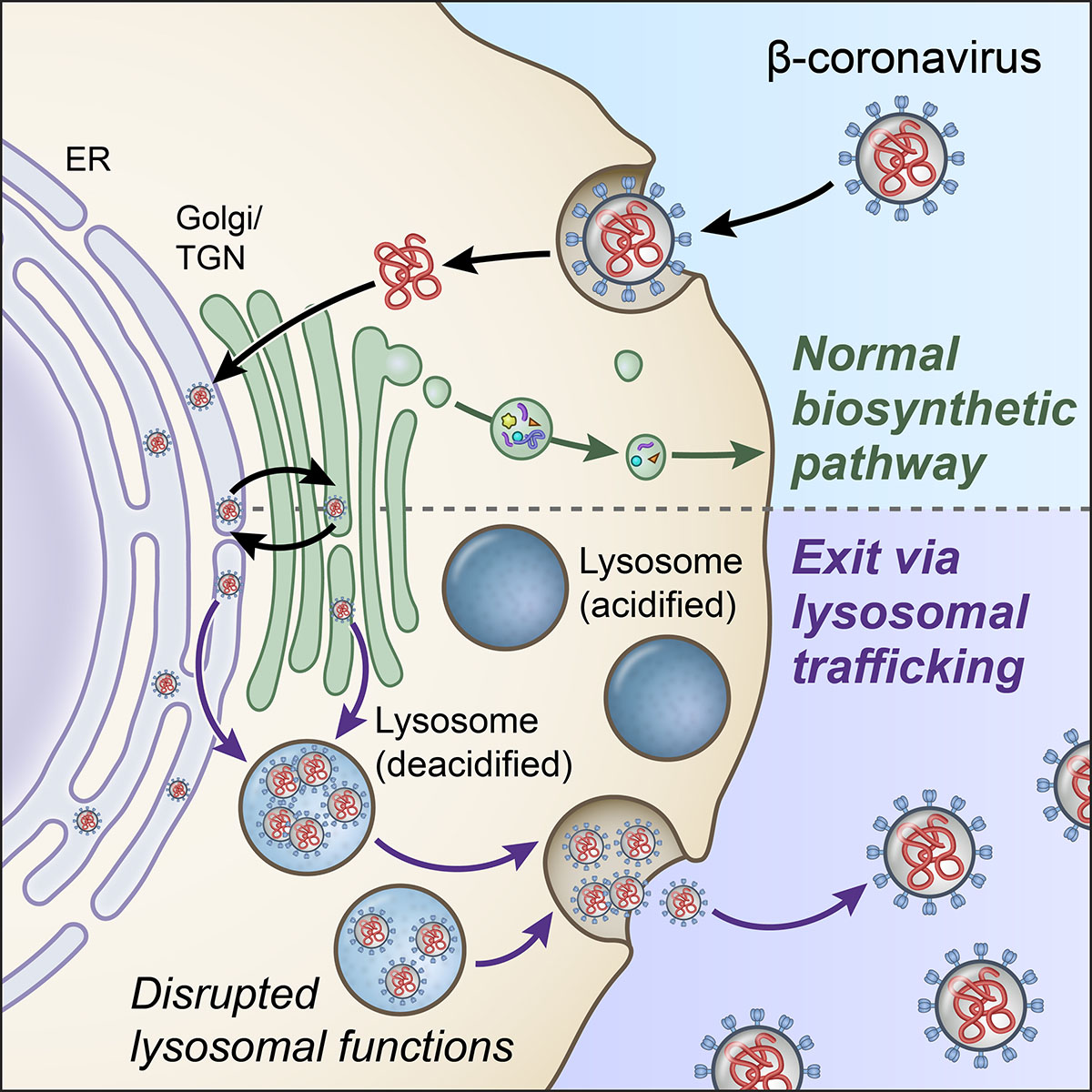
News Release
Wednesday, October 28, 2020
Targeting cells’ ‘trash compactor’ could lead to new antiviral strategy to fight COVID-19.
Researchers at the National Institutes of Health have discovered a biological pathway that the novel coronavirus appears to use to hijack and exit cells as it spreads through the body. A better understanding of this important pathway may provide vital insight in stopping the transmission of the virus—SARS-CoV-2—which causes COVID-19 disease.
In cell studies, the researchers showed for the first time that the coronavirus can exit infected cells through the lysosome, an organelle known as the cells’ “trash compactor.” Normally the lysosome destroys viruses and other pathogens before they leave the cells. However, the researchers found that the coronavirus deactivates the lysosome’s disease-fighting machinery, allowing it to freely spread throughout the body.
argeting this lysosomal pathway could lead to the development of new, more effective antiviral therapies to fight COVID-19. The findings, published today in the journal Cell, come at a time when new coronavirus cases are surging worldwide, with related U.S. deaths nearing 225,000.
Scientists have known for some time that viruses enter and infect cells and then use the cell’s protein-making machinery to make multiple copies of themselves before escaping the cell. However, researchers have only a limited understanding of exactly how viruses exit cells.
Conventional wisdom has long held that most viruses—including influenza, hepatitis C, and West Nile—exit through the so-called biosynthetic secretory pathway. That’s a central pathway that cells use to transport hormones, growth factors, and other materials to their surrounding environment. Researchers have assumed that coronaviruses also use this pathway.
But in a pivotal experiment, Nihal Altan-Bonnet, Ph.D., chief of the Laboratory of Host-Pathogen Dynamics at the NIH’s National Heart, Lung, and Blood Institute (NHLBI) and her post-doctoral fellow Sourish Ghosh, Ph.D., the study’s main authors, found something different. She and her team exposed coronavirus-infected cells (specifically, mouse hepatitis virus) to certain chemical inhibitors known to block the biosynthetic pathway.
“To our shock, these coronaviruses got out of the cells just fine,” Altan-Bonnet said. “This was the first clue that maybe coronaviruses were using another pathway.”
To look for that pathway, the researchers designed additional experiments using microscopic imaging and virus-specific markers involving human cells. They discovered that coronaviruses somehow target the lysosomes, which are highly acidic, and congregate there.
That finding raised yet another question for Altan-Bonnet’s team: If coronaviruses are accumulating in lysosomes and lysosomes are acidic, why are the coronaviruses not destroyed before exiting?
In a series of advanced experiments, the researchers demonstrated that lysosomes get de-acidified in coronavirus-infected cells, significantly weakening the activity of their destructive enzymes. As a result, the viruses remain intact and ready to infect other cells when they exit.
“These coronaviruses are very sneaky,” Altan-Bonnet said. “They’re using these lysosomes to get out, but they’re also disrupting the lysosome so it can’t do its job or function.”
The researchers also discovered that disrupting normal lysosome function appears to harm the cells’ immunological machinery. “We think this very fundamental cell biology finding could help explain some of the things people are seeing in the clinic regarding immune system abnormalities in COVID patients,” Altan-Bonnet said. This includes cytokine storms, in which an excess of certain pro-inflammatory proteins in the blood of COVID patients overwhelm the immune system and cause high death rates.
Now that this mechanism has been identified, researchers may be able to find ways to disrupt this pathway and prevent lysosomes from delivering viruses to the outside of the cell; or re-acidify lysosomes in order to restore their normal functions in coronavirus-infected cells so they can fight COVID. The authors have already identified one experimental enzyme inhibitor that potently blocks coronaviruses from getting out of the cell.
“The lysosome pathway offers a whole different way of thinking about targeted therapeutics,” she said, adding that further studies will be needed to determine if such interventions will be effective and whether existing drugs can help block this pathway. She notes the findings could go a long way toward stemming future pandemics caused by other coronaviruses that may emerge.
Research reported in this study was funded by the Division of Intramural Research of NHLBI, part of the National Institutes of Health. Additionally, the research was supported by NIH grants including NIH R01 AI091985-05; NIH R01 NS36592; F32-AI113973; NIH R37GM058615; and NIH R01AI135270. All other co-authors were supported by intramural NIH and National Cancer Institute funds.
Study: β-Coronaviruses use lysosomes for egress instead of the biosynthetic secretory pathway DOI: 10.1016/j.cell.2020.10.039
This news release describes a basic research finding. Basic research increases our understanding of human behavior and biology, which is foundational to advancing new and better ways to prevent, diagnose, and treat disease. Science is an unpredictable and incremental process — each research advance builds on past discoveries, often in unexpected ways. Most clinical advances would not be possible without the knowledge of fundamental basic research.
About the National Heart, Lung, and Blood Institute (NHLBI): NHLBI is the global leader in conducting and supporting research in heart, lung, and blood diseases and sleep disorders that advances scientific knowledge, improves public health, and saves lives. For more information, visit www.nhlbi.nih.gov.
About the National Institutes of Health (NIH): NIH, the nation's medical research agency, includes 27 Institutes and Centers and is a component of the U.S. Department of Health and Human Services. NIH is the primary federal agency conducting and supporting basic, clinical, and translational medical research, and is investigating the causes, treatments, and cures for both common and rare diseases. For more information about NIH and its programs, visit www.nih.gov.
NIH…Turning Discovery Into Health®
"that" - Google News
October 29, 2020 at 03:07AM
https://ift.tt/3oAzfmm
NIH scientists discover key pathway in lysosomes that coronaviruses use to exit cells - National Institutes of Health
"that" - Google News
https://ift.tt/3d8Dlvv

Tidak ada komentar:
Posting Komentar